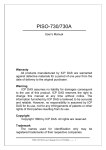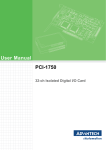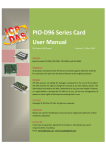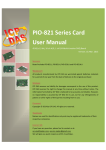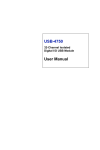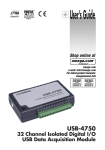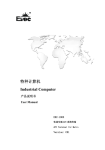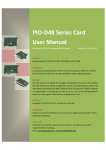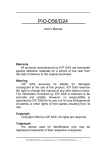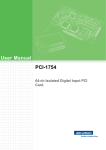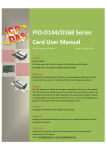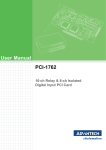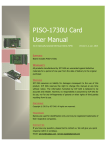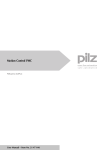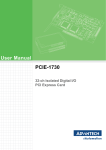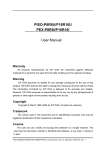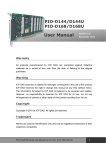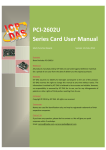Download PISO-730 Series Card User Manual
Transcript
PISO-730 Series Card User Manual 32-ch Isolated DIO and 32-ch TTL DIO Board Version 4.0, Aug. 2015 SUPPORTS Board includes PEX-730, PISO-730U, PISO-730U-5V, PISO-730, PISO-730A and PISO-730A-5V WARRANTY All products manufactured by ICP DAS are warranted against defective materials for a period of one year from the date of delivery to the original purchaser. WARNING ICP DAS assumes no liability for damages consequent to the use of this product. ICP DAS reserves the right to change this manual at any time without notice. The information furnished by ICP DAS is believed to be accurate and reliable. However, no responsibility is assumed by ICP DAS for its use, nor for any infringements of patents or other rights of third parties resulting from its use. COPYRIGHT Copyright © 2014 by ICP DAS. All rights are reserved. TRADEMARK Names are used for identification only and may be registered trademarks of their respective companies. CONTACT US If you have any question, please feel to contact us. We will give you quick response within 2 workdays. Email: [email protected], [email protected] PISO-730 Series Card 32-ch Isolated DIO and 32-ch TTL DIO TABLE OF CONTENTS 1. INTRODUCTION ................................................................................................................................................. 4 1.1 PACKING LIST........................................................................................................................................................ 6 1.2 FEATURES ............................................................................................................................................................ 7 1.3 APPLICATIONS ...................................................................................................................................................... 7 1.4 SPECIFICATIONS .................................................................................................................................................... 8 1.4.1 PEX-730/PISO-730U(-5V)/PISO-730 .................................................................................................................... 8 1.4.2 PISO-730A (-5V) ................................................................................................................................................ 10 2. HARDWARE CONFIGURATION ...........................................................................................................................12 2.1 BOARD L AYOUT .................................................................................................................................................. 12 2.1.1 PISO-730/PISO-730A(-5V) ................................................................................................................................. 12 2.1.2 PISO-730U(-5V)/PEX-730 .................................................................................................................................. 13 2.2 I/O OPERATION .................................................................................................................................................. 14 2.2.1 Non-Isolation D/O Port Architecture (CON3) .................................................................................................... 14 2.2.2 Non-Isolation D/I Port Architecture (CON2) ..................................................................................................... 15 2.2.3 Isolation D/O Port Architecture (CON1) ............................................................................................................ 16 2.2.4 Isolation D/I Port Architecture (CON1) ............................................................................................................. 18 2.3 INTERRUPT OPERATION ........................................................................................................................................ 19 2.3.1 Interrupt Block Diagram ................................................................................................................................... 20 2.3.2 INT_CHAN_0 ..................................................................................................................................................... 21 2.3.3 INT_CHAN_1 ..................................................................................................................................................... 22 2.3.4 Initial_High, Active_Low Interrupt Source ........................................................................................................ 23 2.3.5 Initial_Low, Active_High Interrupt Source ........................................................................................................ 25 2.3.6 Multiple Interrupt Source ................................................................................................................................. 27 2.4 CARD ID SWITCH ................................................................................................................................................ 29 2.5 PIN ASSIGNMENTS............................................................................................................................................... 30 3. HARDWARE INSTALLATION ...............................................................................................................................31 4. SOFTWARE INSTALLATION ................................................................................................................................35 4.1 OBTAINING/INSTALLING THE DRIVER INSTALLER PACKAGE ............................................................................................ 35 4.2 PNP DRIVER INSTALLATION ................................................................................................................................... 36 4.3 VERIFYING THE INSTALLATION ................................................................................................................................ 37 4.3.1 How do I get into Windows Device Manager? ................................................................................................. 37 4.3.2 Check that the Installation ............................................................................................................................... 39 User Manual, Ver. 4.0, Aug. 2015, PMH-0004-40 Page: 2 PISO-730 Series Card 32-ch Isolated DIO and 32-ch TTL DIO 5. TESTING PISO-730 SERIES CARD ........................................................................................................................40 5.1 SELF-TEST WIRING .............................................................................................................................................. 40 5.1.1 Non-isolation (5V/TTL) DIO Test Wiring ...................................................................................................... 40 5.1.2 Isolation DIO Test Wiring ............................................................................................................................ 41 5.2 6. EXECUTE THE TEST PROGRAM ................................................................................................................................ 45 I/O CONTROL REGISTER ....................................................................................................................................47 6.1 HOW TO FIND THE I/O ADDRESS ............................................................................................................................ 47 6.1.1 PIO_PISO Utility........................................................................................................................................... 48 6.2 THE ASSIGNMENT OF I/O ADDRESS ........................................................................................................................ 51 6.3 THE I/O ADDRESS MAP ....................................................................................................................................... 53 6.3.1 RESET\ Control Register............................................................................................................................. 54 6.3.2 AUX Control Register ................................................................................................................................. 54 6.3.3 AUX Data Register ..................................................................................................................................... 54 6.3.4 INT Mask Control Register ......................................................................................................................... 55 6.3.5 AUX Status Register ................................................................................................................................... 55 6.3.6 Interrupt Polarity Control Register ............................................................................................................ 56 6.3.7 I/O Data Register....................................................................................................................................... 57 6.3.8 D/O Readback Register ............................................................................................................................. 58 6.3.9 Card ID Register......................................................................................................................................... 59 6.3.10 7. Ver No Register ..................................................................................................................................... 59 DEMO PROGRAMS............................................................................................................................................60 7.1 DEMO PROGRAM FOR WINDOWS .......................................................................................................................... 60 7.2 DEMO PROGRAM FOR DOS .................................................................................................................................. 62 7.2.1 Demo1: DO Demo ..................................................................................................................................... 64 7.2.2 Demo2: DIO Demo .................................................................................................................................... 66 7.2.3 Demo3: Interrupt (DI0 initial high) ............................................................................................................ 68 7.2.4 Demo4: Interrupt (DI0 initial low) ............................................................................................................... 70 7.2.5 Demo5: Interrupt (Multi interrupt source) .................................................................................................. 73 APPENDIX: DAUGHTER BOARD ....................................................................................................................................76 A1. DB-16P Isolated Input Board ............................................................................................................................... 76 A2. DB-16R Relay Board ............................................................................................................................................ 77 A3. DB-24PR, DB-24POR and DB-24C ........................................................................................................................ 78 A4. Daughter Board comparison Table ...................................................................................................................... 79 User Manual, Ver. 4.0, Aug. 2015, PMH-0004-40 Page: 3 PISO-730 Series Card 32-ch Isolated DIO and 32-ch TTL DIO 1. Introduction The PEX-730 and PISO-730U card is the new generation product that ICP DAS provides to meet RoHS compliance requirement. The PISO-730U card is designed as a drop-in replacement for the PISO-730, while the PEX-730 card is designed as easy replacement for the PISO-730. Users can replace the PISO-730 by the PEX-730 and PISO-730U directly without software/driver modification. PEX-730/PISO-730U(-5V)/PISO-730/PISO-730A(-5V) cards provide 32 isolated digital I/O channels (16 x DI and 16 x DO) and 32 TTL-level digital I/O channels (16 x DI and 16 x DO). Both the isolated DI and DO channels use a short optical transmission path to transfer an electronic signal between the elements of a circuit and keep them electrically isolated. With 3750 V rms isolation protection, these DIO channels allow the input signals to be completely floated so as to prevent ground loops and isolate the host computer from damaging voltages. Each digital output offers a NPN (Current Sinking for PEX-730/PISO-730U(-5V)/PISO-730) or PNP (Current Sourcing for PISO-730A(-5V)) transistor and integrated suppression diode for the inductive load. The open collector outputs (DO channels) are typically used for alarm and warning notification, signal output control, control for external circuits that require a higher voltage level, and signal transmission applications, etc. The PEX-730 and PISO-730U(-5V) also adds a Card ID switch on-board. Users can set Card ID and then recognize the board by the ID via software when using two or more cards in one computer. These cards support various OS versions, such as Linux, DOS, Windows 98/NT/2000, 32/64-bit Windows 8/7/Vista/XP. DLL and Active X control together with various language sample programs based on Turbo C++, Borland C++, Microsoft C++, Visual C++, Borland Delphi, Borland C++ Builder, Visual Basic, C#.NET, Visual Basic.NET and LabVIEW are provided in order to help users quickly and easily develop their own applications. User Manual, Ver. 4.0, Aug. 2015, PMH-0004-40 Page: 4 PISO-730 Series Card 32-ch Isolated DIO and 32-ch TTL DIO Comparison Table D/I Model Name Bus Non-Isolated (5V/TTL) D/O Channels Isolated Non-Isolated (5V/TTL) Isolated Channel Channel Input Voltage Channel Channel Type PCI Express 16 16 Logic 1: 9 ~ 24 V 16 16 Sink, NPN PISO-730U Universal PCI 16 16 Logic 1: 9 ~ 24 V 16 16 Sink, NPN PISO-730U-5V Universal PCI 16 16 Logic 1: 5 ~ 12 V 16 16 Sink, NPN PISO-730 5 V PCI 16 16 Logic 1: 5 ~ 12 V 16 16 Sink, NPN PISO-730A 5 V PCI 16 16 Logic 1: 9 ~ 24 V 16 16 Source, PNP PISO-730A-5V 5 V PCI 16 16 Logic 1: 5 ~ 12 V 16 16 Source, PNP PEX-730 User Manual, Ver. 4.0, Aug. 2015, PMH-0004-40 Page: 5 PISO-730 Series Card 32-ch Isolated DIO and 32-ch TTL DIO 1.1 Packing List The shipping package includes the following items: One multi-function card as follows: PEX Series PEX-730 PISO-730 series: PISO-730U, PISO-730U-5V, PISO-730 PISO-730A series: PISO-730A, PISO-730A-5V One printed Quick Start Guide One software utility CD One CA-4002 D-Sub Connect Note: If any of these items are missing or damaged, please contact the local distributor for more information. Save the shipping materials and cartons in case you need to ship the card in the future. User Manual, Ver. 4.0, Aug. 2015, PMH-0004-40 Page: 6 PISO-730 Series Card 32-ch Isolated DIO and 32-ch TTL DIO 1.2 Features Support the +5V PCI bus for PISO-730(-5V)/PISO-730A(-5V) Support the +3.3/+5 V PCI bus for PISO-730U Supports PCI Express x 1 for PEX-PEX-730 64 DIO channels (32 Isolated channels, 32 Non-isolated channels) 3750 Vrms photo-isolated protection Built-in DC/DC converter with 3000 VDC isolated Output status readback function for PISO-730U/PEX-730 Supports Card ID (SMD Switch) for PISO-730U/PEX-730 Two Interrupt sources SMD, Sort card, power saving Supports Plug&Play to obtain I/O resources No more manually setting of I/O address and IRQ 1.3 Applications Factory automation Product test Laboratory automation User Manual, Ver. 4.0, Aug. 2015, PMH-0004-40 Page: 7 PISO-730 Series Card 32-ch Isolated DIO and 32-ch TTL DIO 1.4 Specifications 1.4.1 PEX-730/PISO-730U(-5V)/PISO-730 Model Name PEX-730 PISO-730U PISO-730 PISO-730U-5V Digital Input Isolation Voltage Channels Compatibility Input 3750 Vrms Isolated 16 Non-Isolated 16 Isolated Optical Non-Isolated 5V/TTL Isolated Logic 0: 0 ~ 1 V Logic 1: 9 ~ 24 V (Logic 1: Min. 7 V; Max. 30 V) V; Max. 16 V) Voltage Logic 0: 0.8 V max. Logic 1: 2.0 V min. Non-Isolated Input Impedance Response Speed Logic 0: 0 ~ 1 V Logic 1: 5 ~ 12 V (Logic 1: Min. 3.5 1.2 KΩ, 1 W Isolated Non-Isolated 4 kHz (Typical) 500 kHz 1.2 MHz Digital Output Isolation Voltage Channels Compatibility Output Voltage 3750 Vrms 16 16 16 16 Isolated Sink, Open Collector Non-Isolated 5V/TTL Non-Isolated Logic 0: 0.4 V max. Logic 1: 2.4 V min. Output Capability Isolated Response Isolated Speed Non-Isolated 100 mA/+30 V for one channel @ 100% duty Sink: 2.4 mA @ 0.8 V Source: 0.8 mA @ 2.0 V Non-Isolated 4 kHz (Typical) 500 kHz 500 kHz User Manual, Ver. 4.0, Aug. 2015, PMH-0004-40 Page: 8 PISO-730 Series Card 32-ch Isolated DIO and 32-ch TTL DIO Model Name PEX-730 PISO-730U PISO-730 PISO-730U-5V General Bus Type 3.3 V / 5 V PCI Express Universal x1 PCI, 32-bit, 33 MHz Data Bus Card ID 8-bit Yes (4-bit) I/O Connector Dimensions (L x W x D) Power Consumption Operating Temperature Storage Temperature Humidity 3.3 V / 5 V 5 V PCI, 32-bit, Universal PCI, 33 MHz 32-bit, 33 MHz - Yes (4-bit) Female DB37 x 1 20-pin box header x 2 163 mm x 116 mm x 22 mm 180 mm x 105 mm x 22 mm 600 mA @ +5 V 0 ~ 60 °C -20 ~ 70 °C 5 ~ 85% RH, non-condensing User Manual, Ver. 4.0, Aug. 2015, PMH-0004-40 Page: 9 PISO-730 Series Card 32-ch Isolated DIO and 32-ch TTL DIO 1.4.2 PISO-730A (-5V) Model Name PISO-730A PISO-730A-5V Digital Input Isolation Voltage Channels Compatibility Input 3750 Vrms Isolated 16 Non-Isolated 16 Isolated Optical Non-Isolated 5V/TTL Isolated Voltage Non-Isolated Input Impedance Logic 0: 0 ~ 1 V Logic 1: 9 ~ 24 V (Logic 1: Min. 7 V; Max. 30 V) Logic 0: 0 ~ 1 V Logic 1: 5 ~ 12 V (Logic 1: Min. 3.5 V; Max. 16 V) Logic 0: 0.8 V max. Logic 1: 2.0 V min. 1.2 KΩ, 1 W Response Isolated Speed Non-Isolated 4 kHz (Typical) 1.2 MHz Digital Output Isolation Voltage Channels Compatibility Output Voltage 3750 Vrms 16 16 16 16 Isolated Source, Open Collector Non-Isolated 5V/TTL Non-Isolated Logic 0: 0.4 V max. Logic 1: 2.4 V min. Output Capability Isolated Response Speed Isolated Non-Isolated Non-Isolated 100 mA/+30 V for one channel @ 100% duty Sink: 2.4 mA @ 0.8 V Source: 0.8 mA @ 2.0 V 4 kHz (Typical) 1.2 MHz User Manual, Ver. 4.0, Aug. 2015, PMH-0004-40 Page: 10 PISO-730 Series Card 32-ch Isolated DIO and 32-ch TTL DIO Model Name PISO-730A PISO-730A-5V General Bus Type 5 V PCI, 32-bit, 33 MHz Data Bus 8-bit Card ID I/O Connector Dimensions (L x W x D) Power Consumption Operating Temperature Storage Temperature Humidity Female DB37 x 1 20-pin box header x 2 180 mm x 105 mm x 22 mm 640 mA @ +5 V 0 ~ 60 °C -20 ~ 70 °C 5 ~ 85% RH, non-condensing User Manual, Ver. 4.0, Aug. 2015, PMH-0004-40 Page: 11 PISO-730 Series Card 32-ch Isolated DIO and 32-ch TTL DIO 2. Hardware Configuration 2.1 Board Layout 2.1.1 PISO-730/PISO-730A(-5V) PISO-730 PISO-730A CON2 JP1 IN CON1 OUT PCI controller CON3 CON1 The terminal for isolation digital input/output CON2 The terminal for TTL digital input CON3 The terminal for TTL digital output Refer to Sec.2.5 for more detailed about pin assignments information. JP1 Reserved - User Manual, Ver. 4.0, Aug. 2015, PMH-0004-40 Page: 12 PISO-730 Series Card 32-ch Isolated DIO and 32-ch TTL DIO 2.1.2 PISO-730U(-5V)/PEX-730 PISO-730U PISO-730U-5V CON2 SW1 ON IN CON1 OUT PCI controller CON3 JP1 PEX-730 CON2 SW1 ON CON1 DI JP1 PCI controller DO CON3 CON1 The terminal for isolation digital input/output CON2 The terminal for TTL digital input CON3 The terminal for TTL digital output Refer to Sec.2.5 for more detailed about pin assignments information. JP1 Reserved - SW1 Card ID function Refer to Sec.2.4 User Manual, Ver. 4.0, Aug. 2015, PMH-0004-40 Page: 13 PISO-730 Series Card 32-ch Isolated DIO and 32-ch TTL DIO 2.2 I/O Operation 2.2.1 Non-Isolation D/O Port Architecture (CON3) When the PC is powered-up, all operations of non-isolated DO states are cleared to low state. The RESET\ signal is used to clear non-isolated DO states. Refer to Sec. 6.3.1 for more information about the RESET\ signal. The RESET\ is in Low-state all non-isolated DO states are clear to low state The block diagram of Non-isolated DO is as follows: Figure 2-1 RESET\ Clear Data Latch Input CON3 Clock Input D/O buffer CKT User Manual, Ver. 4.0, Aug. 2015, PMH-0004-40 Page: 14 PISO-730 Series Card 32-ch Isolated DIO and 32-ch TTL DIO 2.2.2 Non-Isolation D/I Port Architecture (CON2) When the PC is powered-up, non-isolated DI port operations are disabled. The enable/disable for non-isolated DI ports is controlled by the RESET\ signal. Refer to Sec. 6.3.1 for more information about the RESET\ signal. The RESET\ is in Low-state all non-isolated DI operation are disabled The RESET\ is in High-state all non-isolated DI operation are enabled The block diagram of Non-isolated DI is as follows: Figure 2-2 RESET\ Disable Data Input Buffer CON2 Clock Input D/I buffer CKT User Manual, Ver. 4.0, Aug. 2015, PMH-0004-40 Page: 15 PISO-730 Series Card 32-ch Isolated DIO and 32-ch TTL DIO 2.2.3 Isolation D/O Port Architecture (CON1) When the PC is powered-up, all operations of isolated DO states are cleared to low state. The RESET\ signal is used to clear isolated DO states. Refer to Sec. 6.3.1 for more information about RESET\ signal. The RESET\ is in Low-state all isolated DO states are clear to low state Each eight open-collector output channel shares EO.COM (IDO0 to IDO7 use EO.COM1 and IDO8 to IDO15 use EO.COM2) The block diagram of isolated DO (Current Sinking) is as follows: Figure 2-3 PEX-730/PISO-730U/PISO-730(-5V) EO.COM IDO0 LOAD Diode1 IDO1 LOAD Diode2 IDO7 LOAD Diode3 IGND Internal External Power supply External (Recommend: It is necessary to connect a diode (..3..). In the external device end as means of preventing damage form the counter emf. If your external device is inductive load, Ex. Relay...etc.) User Manual, Ver. 4.0, Aug. 2015, PMH-0004-40 Page: 16 PISO-730 Series Card 32-ch Isolated DIO and 32-ch TTL DIO The block diagram of isolated DO (Current Sourcing) is as follows: Figure 2-4 PISO-730A(-5V) EO.COM1 Diode1 IDO0 LOAD IGND Diode2 IDO1 LOAD IGND Diode3 IDO7 IGND Internal LOAD External Power supply External (Recommend: It is necessary to connect a diode (..3..). In the external device end as means of preventing damage form the counter emf. If your external device is inductive load, Ex. Relay...etc.) User Manual, Ver. 4.0, Aug. 2015, PMH-0004-40 Page: 17 PISO-730 Series Card 32-ch Isolated DIO and 32-ch TTL DIO 2.2.4 Isolation D/I Port Architecture (CON1) The PISO-730 series cards provide 16-channel isolated digital input. The PEX-730, PISO-730U, PISO-730 and PISO-730A each of the isolated digital input can accept voltages from 9 VDC to 30 VDC. The PISO-730U-5V and PISO-730A-5V each of the isolated digital input can accept voltages from 5 VDC to 12 VDC. Each eight input channels share one external common end point. (IDI0 to IDI7 use EI.COM1 and IDI8 to IDI15 use EI.COM2) Figure 2-5 PEX-730/PISO-730U/PISO-730(-5V)/PISO-730A(-5V) Vcc 1.2 K/1 W IDI0 1.2 K/1 W IDI1 1.2 K/1 W IDI7 External Power Supply EI.COM1 Internal External User Manual, Ver. 4.0, Aug. 2015, PMH-0004-40 Page: 18 PISO-730 Series Card 32-ch Isolated DIO and 32-ch TTL DIO 2.3 Interrupt Operation There are two interrupt sources in PISO-730 series cards. These two signals are named as INT_CHAN_0 and INT_CHAN_1. Their signal sources are given as follows: INT_CHAN_0: DI0 INT_CHAN_1: DI1 If only one interrupt signal source is used, the interrupt service routine does not have to identify the interrupt source. Refer to Sec. 7.2.3 DEMO3.C and Sec. 7.2.4 DEMO4.C for more information. If there is more than one interrupt source, the interrupt service routine will identify the active signals as follows: (refer to Sec. 7.2.5 DEMO5.C) 1. Reads the new status of all interrupt signal sources (refer to Sec. 6.3.5) 2. 3. 4. 5. Compares the new status with the old status to identify the active signals If INT_CHAN_0 is active, services it If INT_CHAN_1 is active, services it Updates interrupt status Note: If the interrupt signal is too short, the new status may be as same as old status. In that condition, the interrupt service routine cannot identify which interrupt source is active. So the interrupt signal must be hold_active long enough until the interrupt service routine is executed. This hold_time is different for different O.S. The hold_time can be as short as a micro-second or as long as a second. In general, 20 ms is enough for any O. S. User Manual, Ver. 4.0, Aug. 2015, PMH-0004-40 Page: 19 PISO-730 Series Card 32-ch Isolated DIO and 32-ch TTL DIO 2.3.1 Interrupt Block Diagram Figure 2-6 INT_CHAN_0 INT_CHAN_1 INT\ 0 Level_trigger 0 initial_low active_high The interrupt output signal of PISO-730 series cards, INT\ is a level-trigger, Active_Low signal. If the INT\ generates a low-pulse, the PISO-730 will interrupt the PC once a time. If the INT\ is fixed in low level, the PISO-730 series cards will interrupt the PC continuously. So the INT_CHAN_0/1 must be controlled by pulse_type signals. They must be fixed in low-level state normally and generate a high_pulse to interrupt the PC. The priority of INT_CHAN_0/INT_CHAN_1 is the same. If these two signals are active at the same time, then INT\ will be activated only once. So the interrupt service routine has to read the status of all interrupt channels for a multi-channel interrupt. Refer to Sec. 2.3.6 for more information. Sec. 7.2.5 DEMO5.C for multi-channel interrupt source If only one interrupt source is used, the interrupt service routine doesn’t have to read the status of interrupt source. The demo programs Sec. 7.2.3 DEMO3.C and Sec. 7.2.4 DEMO4.C are designed for single-channel interrupt demo as follows: Sec. 7.2.3 DEMO3.Cand Sec. 7.2.4 DEMO4.C for INT_CHAN_0 only User Manual, Ver. 4.0, Aug. 2015, PMH-0004-40 Page: 20 PISO-730 Series Card 32-ch Isolated DIO and 32-ch TTL DIO 2.3.2 INT_CHAN_0 Figure 2-7 INT_CHAN_0 DI0 Inverted/Noninverted select INV0 Enable/Disable select EN0 The INT_CHAN_0 must be fixed in a normal, low-level state and generate a high_pulse to interrupt the PC. The EN0 can be used to enable/disable the INT_CHAN_0 as follows: (Refer to Sec. 6.3.4) EN0=0 INT_CHAN_0=disable EN0=1 INT_CHAN_0=enable The INV0 can be used to invert/non-invert the DI0 as follows: (Refer to Sec. 6.3.6) INV0=0INT_CHAN_0=invert state of DI0 INV0=1INT_CHAN_0=non-invert state of DI0 Refer to the following demo program for more information: Sec. 7.2.3 DEMO3.C for INT_CHAN_0 (initial high) Sec. 7.2.4 DEMO4.C for INT_CHAN_0 (initial low) Sec. 7.2.5 DEMO5.C for multi-channel interrupt source Note: Refer to Sec. 2.3.4 and Sec. 2.3.5 for active high-pulse generation. User Manual, Ver. 4.0, Aug. 2015, PMH-0004-40 Page: 21 PISO-730 Series Card 32-ch Isolated DIO and 32-ch TTL DIO 2.3.3 INT_CHAN_1 Figure 2-8 INT_CHAN_1 DI1 Inverted/Noninverted select INV1 Enable/Disable select EN1 The INT_CHAN_1 must be fixed in a normal low-level state and generated a high_pulse to interrupt the PC. The EN1 can be used to enable/disable the INT_CHAN_1 as follows: (Refer to Sec. 6.3.4) EN1=0 INT_CHAN_1=disable EN1=1 INT_CHAN_1=enable The INV1 can be used to invert/non-invert the DI1 as follows: (Refer to Sec. 6.3.6) INV1=0INT_CHAN_1=invert state of DI1 INV1=1INT_CHAN_1=non-invert state of DI1 Refer to demo program for more information as follows: Sec. 7.2.3 DEMO3.C for INT_CHAN_0 (initial high) Sec. 7.2.4 DEMO4.C Sec. 7.2.5 DEMO5.C for INT_CHAN_0 (initial low) for multi-channel interrupt source Note: Refer to Sec. 2.3.4 and Sec. 2.3.5 for active high-pulse generation. User Manual, Ver. 4.0, Aug. 2015, PMH-0004-40 Page: 22 PISO-730 Series Card 32-ch Isolated DIO and 32-ch TTL DIO 2.3.4 Initial_High, Active_Low Interrupt Source If the DI0 is an initial_high, active_low signal, the interrupt service routine should use INV0 to invert/non-invert the DI0 for high_pulse generation as follows: (Refer to Sec. 7.2.3 DEMO3.C and the DI1 is similarly) Initial set: now_int_state=1; outportb(wBase+0x2a,0); void interrupt irq_service() { if (now_int_state==1) { COUNT_L++; If((inport(wBase+7)&1)==0) { outportb(wBase+0x2a,1); now_int_state=0; } else now_int_state=1; } else { COUNT_H++; If((inport(wBase+7)&1)==1) { outportb(wBase+0x2a,0); now_int_state=1; } else now_int_state=0; /* initial state for DI0 */ /* select the inverted DI0 */ /* now DI0 is changed to LOW, refer to Figure 2-9 */(a) /* INT_CHAN_0=!DI0=HIGH now */ /* find a LOW_pulse (DI0) */ /* the DI0 is still fixed in LOW */ /* needs to generate a high_pulse */ /* INV0 select the non-inverted input, refer to Figure 2-9 */(b) /* INT_CHAN_0=DI0=LOW --> */ /* INT_CHAN_0 generate a high_pulse */ /* now DI0=LOW */ /* now DI0=HIGH */ /* now DI0 is changed to HIGH, refer to Figure 2-9 */(c) /* INT_CHAN_0=DI0=HIGH now */ /* find a HIGH_pulse (DI0) */ /* the DI0 is still fixed in HIGH */ /* needs to generate a high_pulse */ /* INV0 select the inverted input, refer to Figure 2-9 */(d) /* INT_CHAN_0=!DI0=LOW */ /* INT_CHAN_0 generate a high_pulse */ /* now DI0=HIGH */ /* now DI0=LOW */ } if (wIrq>=8) outportb(A2_8259,0x20); outportb(A1_8259,0x20); User Manual, Ver. 4.0, Aug. 2015, PMH-0004-40 Page: 23 PISO-730 Series Card 32-ch Isolated DIO and 32-ch TTL DIO (a) (b) (c) (d) Figure 2-9 DI0 INV0 INT_CHAN_0 User Manual, Ver. 4.0, Aug. 2015, PMH-0004-40 Page: 24 PISO-730 Series Card 32-ch Isolated DIO and 32-ch TTL DIO 2.3.5 Initial_Low, Active_High Interrupt Source If the DI0 is an initial_low, active_high signal, the interrupt service routine should use INV0 to invert/non-invert the DI0 for high_pulse generation as follows: (Refer to Sec. 7.2.4 DEMO4.C and the DI1 is similarly) Initial set: now_int_state=0; outportb(wBase+0x2a,1); void interrupt irq_service() { if (now_int_state==1) { COUNT_L++; If((inport(wBase+7)&1)==0) { outportb(wBase+0x2a,1); now_int_state=0; } else now_int_state=1; /* initial state for DI0 */ /* select the non-inverted DI0 */ /* now DI0 is changed to LOW, refer to Figure 2-10 */(c) /* INT_CHAN_0=!DI0=HIGH now */ /* find a LOW_pulse (DI0) */ /* the DI0 is still fixed in LOW */ /* needs to generate a high_pulse */ /* INV0 select the non-inverted input, refer to Figure 2-10 /* INT_CHAN_0=DI0=LOW */ /* INT_CHAN_0 generate a high_pulse */ /* now DI0=LOW */ /* now DI0=HIGH se } else { COUNT_H++; If((inport(wBase+7)&1)==1) { outportb(wBase+0x2a,0); now_int_state=1; } else now_int_state=0; */(d) */ */ (a) /* now DI0 is changed to HIGH, refer to Figure 2-10 */ /* INT_CHAN_0=DI0=HIGH now */ /* find a High_pulse (DI0) */ /* the DI0 is still fixed in HIGH */ /* needs to generate a high_pulse */ /* INV0 select the inverted input, refer to Figure 2-10 */(b) /* INT_CHAN_0=!DI0=LOW */ /* INT_CHAN_0 generate a high_pulse */ /* now DI0=HIGH */ /* now DI0=LOW */ } if (wIrq>=8) outportb(A2_8259,0x20); outportb(A1_8259,0x20); } User Manual, Ver. 4.0, Aug. 2015, PMH-0004-40 Page: 25 PISO-730 Series Card 32-ch Isolated DIO and 32-ch TTL DIO (a) (b) (c) (d) Figure 2-10 DI0 INV0 INT_CHAN_0 User Manual, Ver. 4.0, Aug. 2015, PMH-0004-40 Page: 26 PISO-730 Series Card 32-ch Isolated DIO and 32-ch TTL DIO 2.3.6 Multiple Interrupt Source Assume: DI0 is initial Low, active High DI1 is initial High, active Low as follows: Figure 2-10 DI0 DI1 DI0 & DI1 are active at the same time DI0 & DI1 are return to normal at the same time DI1 is return to normal DI1 is active Refer to Sec. 7.2.5 DEMO5.C for source program. These three falling-edge and rising-edge scenarios can be detected by Sec. 7.2.5 DEMO5.C. Note: When the interrupt is active, the user program has to identify the active signals. More than one signal may be simultaneously. The interrupt service routine has to service all active signals at the same time. User Manual, Ver. 4.0, Aug. 2015, PMH-0004-40 Page: 27 PISO-730 Series Card 32-ch Isolated DIO and 32-ch TTL DIO Initial set: now_int_state=0x2; invert=0x1; /* Initial state: DI0 at low level, DI1 at high level /* non-invert DI0 & invert DI1 */ */ outportb(wBase+0x2a,invert); void interrupt irq_service() { new_int_state=inportb(wBase+7)&0x03; int_c=new_int_state^now_int_state; if ((int_c&0x1)!=0) { if ((new_int_state&0x01)!=0) { CNT_H1++; } else { CNT_L1++; } invert=invert^1; } if ((int_c&0x2)!=0) { if ((new_int_state&0x02)!=0) { CNT_H2++; } else { CNT_L2++; } invert=invert^2; } now_int_state=new_int_state; outportb(wBase+0x2a,invert); if (wIrq>=8) outportb(A2_8259,0x20); outportb(A1_8259,0x20); } /* read all interrupt state */ /* compare which interrupt */ /* signal has changed */ /* INT_CHAN_0 is active */ /* now DI0 changes to high */ /* now DI0 changes to low */ /* to generate a high pulse */ /* now DI1 change to high /* now DI1 changes to low */ */ /* to generate a high pulse */ User Manual, Ver. 4.0, Aug. 2015, PMH-0004-40 Page: 28 PISO-730 Series Card 32-ch Isolated DIO and 32-ch TTL DIO 2.4 Card ID Switch The PEX-730 and PISO-730U has a Card ID switch (SW1) with which users can recognize the board by the ID via software when using two or more PEX-730 and PISO-730U cards in one computer. The default Card ID is 0x0. For detail SW1 Card ID settings, please refer to Table 2.1. Note that the Card ID function is only supported by the PEX-730 and PISO-730U. NO ID 2 ID 3 ID 1 ID 0 SW1 1 2 3 4 (Default Settings) (*) Default Settings; OFF 1; ON 0 1 2 Card ID (Hex) ID0 ID1 Table 2.1 3 ID2 4 ID3 (*) 0x0 ON ON ON ON 0x1 OFF ON ON ON 0x2 ON OFF ON ON 0x3 OFF OFF ON ON 0x4 ON ON OFF ON 0x5 OFF ON OFF ON 0x6 ON OFF OFF ON 0x7 OFF OFF OFF ON 0x8 ON ON ON OFF 0x9 OFF ON ON OFF 0xA ON OFF ON OFF 0xB OFF OFF ON OFF 0xC ON ON OFF OFF 0xD OFF ON OFF OFF 0xE ON OFF OFF OFF 0xF OFF OFF OFF OFF User Manual, Ver. 4.0, Aug. 2015, PMH-0004-40 Page: 29 PISO-730 Series Card 32-ch Isolated DIO and 32-ch TTL DIO 2.5 Pin Assignments The Pin assignments of CON1, CON2 and CON3 on the PISO-730 series cards are represented in the figure below. CON2/CON3: 20-pin flat-cable headers for 5V/TTL digital input/output. CON2/COM3 are TTL compatible High (1) 2.0 ~ 5.0 V (Voltage over 5.0V will damage the device) None Define 2.0 V ~ 0.8 V Low (0) Under 0.8 V CON1: 37-pin D-type female connector isolation digital for input/output. User Manual, Ver. 4.0, Aug. 2015, PMH-0004-40 Page: 30 PISO-730 Series Card 32-ch Isolated DIO and 32-ch TTL DIO 3. Hardware Installation Note: As certain operating systems, such as Windows XP may require the computer to be restarted after a new driver is installed, it is recommended that the driver is installed first, which will reduce the installation time. Follow the process described below to install your PISO-730 series card: Step 1: Install the PISO-730 series card driver on your computer. For detailed information regarding driver installation, refer to Chapter 4 Software Installation. Step 2: Configuring Card ID by the SW1 DIP-Switch. For detailed information about the card ID (SW1), please refer to Sec. 2.4 Car ID Switch. Note that the Card ID function only supports PEX-730 and PISO-730U. User Manual, Ver. 4.0, Aug. 2015, PMH-0004-40 Page: 31 PISO-730 Series Card 32-ch Isolated DIO and 32-ch TTL DIO Step 3: Correctly shut down and power off your computer, and then disconnect the power supply. Step 4: Remove the cover from the computer. Step 5: Select an empty PCI/PCI Express slot. User Manual, Ver. 4.0, Aug. 2015, PMH-0004-40 Page: 32 PISO-730 Series Card 32-ch Isolated DIO and 32-ch TTL DIO Step 6: Remove the screw holding the cover for the PCI/PCI Express slot in place and then remove the slot cover from the PC. Ensure that you do not misplace the screw. Step 7: Remove the connector cover from the PISO-730 series card. Step 8: Align the contacts of the PCI card with the open slot on your motherboard and carefully insert your PISO-730 series card into the PCI/PCI Express slot. User Manual, Ver. 4.0, Aug. 2015, PMH-0004-40 Page: 33 PISO-730 Series Card 32-ch Isolated DIO and 32-ch TTL DIO Step 9: Screw the mounting bracket screw removed in step 5 into the new PCI card bracket to secure the card in place. Confirm that the PISO-730 series card is correctly mounted on the motherboard. Step 10: Re-attach cover for the computer and reconnect the power supply. Step 11: Power on the computer. Once the computer reboots, follow the onscreen messages to complete the Plug & Play installation process. For more information, refer to Chapter 4 Software Installation. User Manual, Ver. 4.0, Aug. 2015, PMH-0004-40 Page: 34 PISO-730 Series Card 32-ch Isolated DIO and 32-ch TTL DIO 4. Software Installation This chapter provides a detailed description of the process for installing the PISO-730 series driver and how to verify whether the PISO-730 was properly installed. PISO-730 series card can be used on DOS, Linux and Windows 98/ME/2000 and 32-/64-bit XP/2003/Vista/7/8 based systems, and the drivers are fully Plug &Play (PnP) compliant for easy installation. 4.1 Obtaining/Installing the Driver Installer Package The driver installer package for the PISO-730 series card can be found on the supplied CD-ROM, or can be obtained from the ICP DAS FTP web site. Install the appropriate driver for your operating system. The location and addresses are indicated in the Table4-1 and Table4-2 below. Table 4-1: UniDAQ Driver/SDK OS Windows 2000、32/64-bit Windows XP、32/64-bit Windows 2003、 32/64-bit Windows Vista、32/64-bit Windows 7、32/64-bit Windows 2008、 32/64-bit Windows 8 Driver Name UniDAQ Driver/SDK (unidaq_win_setup_xxxx.exe) CD-ROM CD:\\ NAPDOS\PCI\UniDAQ\DLL\Driver\ Web Site http://ftp.icpdas.com/pub/cd/iocard/pci/napdos/pci/unidaq/dll/driver/ Installing Procedure For detailed information about the UniDAQ driver installation, please refer to UniDAQ DLL Software Manual. The user manual is contained in: CD:\NAPDOS\PCI\UniDAQ\Manual\ http://ftp.icpdas.com/pub/cd/iocard/pci/napdos/pci/unidaq/manual/ User Manual, Ver. 4.0, Aug. 2015, PMH-0004-40 Page: 35 PISO-730 Series Card 32-ch Isolated DIO and 32-ch TTL DIO Table 4-2: PISO-DIO Series Classic Driver OS Windows 95/98/ME、Windows NT、Windows 2000、32-bit Windows XP、 32-bit Windows 2003、32-bit Windows Vista、32-bit Windows 7 Driver Name PISO-DIO Series Classic (PISO_DIO_Win__xxx.exe) CD-ROM CD:\\ NAPDOS\PCI\PISO-DIO\DLL_OCX\Driver\ Web Site http://ftp.icpdas.com/pub/cd/iocard/pci/napdos/pci/piso-dio/dll_ocx/driver/ Installing Procedure For detailed information about the PISO-DIO series classic driver installation, please refer to PISO-DIO series classic driver DLL Software Manual. The user manual is contained in: CD:\NAPDOS\PCI\PISO-DIO\Manual\ http://ftp.icpdas.com/pub/cd/iocard/pci/napdos/pci/piso-dio/manual/ 4.2 PnP Driver Installation Power off the computer and install the PISO-730 series cards. Turn on the computer and Windows 95/98/ME/NT/2000 and 32-/64-bit Windows XP/2003/Vista/7/8 should automatically defect the new PCI device(s) and then ask for the location of the driver files for the hardware. If a problem is encountered during installation, refer to the PnPinstall.pdf file for more information. User Manual, Ver. 4.0, Aug. 2015, PMH-0004-40 Page: 36 PISO-730 Series Card 32-ch Isolated DIO and 32-ch TTL DIO 4.3 Verifying the Installation To verify the installation, use the Windows Device Manager to view and update the device drivers installed on your computer, and check to ensure that hardware is operating correctly. The following is a description of how access the Device Manager in each of the major versions of Windows. Refer to the appropriate description for your specific operating system to verify the installation. 4.3.1 How do I get into Windows Device Manager? Microsoft Windows 95/98/ME Step 1: On the desktop right-click on “My Computer” and click “Properties” or open the “Control Panel” and double-click the “System” icon. Step 2: Click the “Device Manager” tab. Microsoft Windows 2000/XP Step 1: Click “Start” then point to “Settings” and click “Control Panel”. Double-click the “System” icon to open the “System Properties” dialog box.. Step 2: Click the “Hardware” tab and then click the “Device Manager” button. Microsoft Windows 2003 Step 1: Click “Start” point to “Administrative Tools”, and then click “Computer Management”. Step 2: From “System Tools” in the console tree, click “Device Manager”. User Manual, Ver. 4.0, Aug. 2015, PMH-0004-40 Page: 37 PISO-730 Series Card 32-ch Isolated DIO and 32-ch TTL DIO Microsoft Windows Vista/7 Step 1: Click “Start” button, and then click “Control Panel”. Step 2: Click “System and Maintenance”, and then click “Device Manager”. Alternatively, Step 1: Click “Start” button. Step 2: In the Search field, type Device Manager and the press Enter. Note that Administrator privileges are required for this operation. If you are prompted for an administrator password or confirmation, type the password or provide confirmation. Microsoft Windows 8 Step 1: To display the Start screen icon from the desktop view, simply hover the mouse cursor over the bottom-left corner of screen. Step 2: Right-click the Start screen icon then click “Device Manager”. Alternatively, press [Windows Key] +[ X] to open the Start Menu, and select Device Manager from the options list. Right-click User Manual, Ver. 4.0, Aug. 2015, PMH-0004-40 Page: 38 PISO-730 Series Card 32-ch Isolated DIO and 32-ch TTL DIO 4.3.2 Check that the Installation Check the PISO-730 series card which listed correctly or not, as illustrated below. Installation successful User Manual, Ver. 4.0, Aug. 2015, PMH-0004-40 Page: 39 PISO-730 Series Card 32-ch Isolated DIO and 32-ch TTL DIO 5. Testing PISO-730 Series Card This chapter can give you the detail steps about self-test. In this way, user can confirm that PISO-730 series cards well or not. Before the self-test, you must complete the hardware and driver installation. For detailed information about the hardware and driver installation, please refer to Chapter 3 Hardware Installation and Chapter 4 Software Installation. 5.1 Self-Test Wiring 5.1.1 Non-isolation (5V/TTL) DIO Test Wiring Preparing the device: Before beginning the “self-test”, ensure that the following items are available: A CA-2002 (optional) cable Step 1: Use the CA-2002 cable to connect the CON2 with CON3 on the PISO-730 series card. Figure 5-1 User Manual, Ver. 4.0, Aug. 2015, PMH-0004-40 Page: 40 PISO-730 Series Card 32-ch Isolated DIO and 32-ch TTL DIO 5.1.2 Isolation DIO Test Wiring Preparing the device: Before beginning the “self-test”, ensure that the following items are available: A DN-37 (optional) terminal board A CA-3710 (optional) cable Exterior power supply device. For example: DP-665 (optional) Step 1: Use the DN-37 to connect the CON1 on the PISO-730 series card. Figure 5-2 Step 2: Connect the CON1.IDI (0-15) with CON1.IDO (0-15). (Pin1 connects to Pin11 … … Pin27 connects to Pin37) Step 3: Connect the EI.COM1 with EI.COM2; Connect the EO.COM1 with EO.COM2. (Pin9 connects to Pin20; Pin10 connects to Pin19) For PEX-730/PISO-730U/PISO-730 External Power Wiring: Step 4: External Power +24 V connect to EO.COM2 (Pin19). External Power +24 V connect to EI.COM2 (Pin28). External Power GND connect to CON1.IGND (pin29). (Refer to Figure 5-3 for illustrations) For PISO-730U-5V External Power Wiring: Step 4: External Power +5 V connect to EO.COM2 (Pin19). External Power +5 V connect to EI.COM2 (Pin28). External Power GND connect to CON1.IGND (pin29). (Refer to Figure 5-4 for illustrations) User Manual, Ver. 4.0, Aug. 2015, PMH-0004-40 Page: 41 PISO-730 Series Card 32-ch Isolated DIO and 32-ch TTL DIO For PISO-730AExternal Power Wiring: Step 4: External Power +24 V connect to EO.COM2 (Pin19). External Power GND connect to EI.COM2 (Pin28). External Power GND connect to CON1.IGND (pin29). (Refer to Figure 5-5 for illustrations) For PISO-730A-5V External Power Wiring: Step 4: External Power +5 V connect to EO.COM2 (Pin19). External Power GND connect to EI.COM2 (Pin28). External Power GND connect to CON1.IGND (pin29). (Refer to Figure 5-6 for illustrations) Note that DI can accept external voltages refer to Sec. 2.2.4 “Isolation D/I Port Architecture (CON1)” for more detail information. For PEX-730/PISO-730U/PISO-730 Wiring Diagram: Figure 5-3 Note that DI can accept external voltages from 9 VDC to 30 VDC. User Manual, Ver. 4.0, Aug. 2015, PMH-0004-40 Page: 42 PISO-730 Series Card 32-ch Isolated DIO and 32-ch TTL DIO For PISO-730U-5V Wiring Diagram: Note that DI can accept external voltages Figure 5-4 from 5 VDC to 12 VDC. For PISO-730A Wiring Diagram: Note that DI can accept external voltages Figure 5-5 from 9 VDC to 30 VDC. User Manual, Ver. 4.0, Aug. 2015, PMH-0004-40 Page: 43 PISO-730 Series Card 32-ch Isolated DIO and 32-ch TTL DIO For PISO-730A-5V Wiring Diagram: Note that DI can accept external voltages Figure 5-6 from 5 VDC to 12 VDC. User Manual, Ver. 4.0, Aug. 2015, PMH-0004-40 Page: 44 PISO-730 Series Card 32-ch Isolated DIO and 32-ch TTL DIO 5.2 Execute the Test Program The following example use UniDAQ driver to perform self-test. If you install the PISO-DIO series classic driver, please refer to Quick Start Guide of the PISO-730 (http://ftp.icpdas.com/pub/cd/iocard/pci/napdos/pci/piso-dio/manual/quickstart/classic/ ) to execute the self-test. Step 1: Execute the UniDAQ Utility Program. The UniDAQ Utility.exe will be placed in the default path (C:\ICPDAS\UniDAQ\Driver\) after completing installation. 1. Double click the “UniDAQUtility.exe” 2. Confirm the PISO-730 series card had successfully installed to PC. It starts form 0. 3. Click the “TEST” button to start test. 1 3 2 Note: The PEX-730 software is fully compatible with the PISO-730 series software. User Manual, Ver. 4.0, Aug. 2015, PMH-0004-40 Page: 45 PISO-730 Series Card 32-ch Isolated DIO and 32-ch TTL DIO Step 2: Get DIO function test result. 1. Click the “Digital Output” tab. 2. Select the “Port0” from the “Port Number” drop-down options. 3. Check channels 0, 2, 4 and 6. 1 3 2 4. Click the “Digital Input” tab. 5. Select the “Port0” from the “Port Number” drop-down options. 6. The corresponding D/I become red for channel 0, 2, 4, 6 of D/O is ON. 4 6 Complete 5 User Manual, Ver. 4.0, Aug. 2015, PMH-0004-40 Page: 46 PISO-730 Series Card 32-ch Isolated DIO and 32-ch TTL DIO 6. I/O Control Register 6.1 How to Find the I/O Address The plug&play BIOS will assign a proper I/O address to every PIO/PISO series card in the power-on stage. The fixed IDs for the PISO-730 series cards are given as follows: Table 6-1: PISO-730 (Rev 1.0 ~ 2.0) PISO-730 (Rev 2.3) PISO-730U (Rev 4.0) PEX-730 Vendor ID 0xE159 0xE159 0xE159 0xE159 Device ID 0x02 0x01 0x01 0x01 Sub-Vendor ID 0x80 0xCA80 0xCA80 0xCA80 Sub-Device ID 0x08 0x00 0x00 0x00 Sub-Aux ID 0x40 0x40 0x40 0x40 Table 6-2: PISO-730A (Rev 2.0) PISO-730A (Rev 3.3) Vendor ID 0xE159 0xE159 Device ID 0x02 0x01 Sub-Vendor ID 0x80 0x62FF Sub-Device ID 0x08 0x00 Sub-Aux ID 0x80 0x80 We provide all necessary functions as follows: 1. PIO_DriverInit(&wBoard, wSubVendor, wSubDevice, wSubAux) 2. PIO_GetConfigAddressSpace(wBoardNo,*wBase,*wIrq, *wSubVendor, *wSubDevice, *wSubAux, *wSlotBus, *wSlotDevice) 3. Show_PIO_PISO(wSubVendor, wSubDevice, wSubAux) User Manual, Ver. 4.0, Aug. 2015, PMH-0004-40 Page: 47 PISO-730 Series Card 32-ch Isolated DIO and 32-ch TTL DIO All functions are defined in PIO.H. Refer to PISO-DIO DLL software manual for more information. The important driver information is given as follows: 1. Resource-allocated information: wBase: BASE address mapping in this PC wIrq: IRQ channel number allocated in this PC 2. PIO/PISO identification information: wSubVendor: subVendor ID of this board wSubDevice: subDevice ID of this board wSubAux: subAux ID of this board 3. PC’s physical slot information: wSlotBus: hardware slot ID1 in this PC’s slot position wSlotDevice: hardware slot ID2 in this PC’s slot position The PIO_PISO.EXE utility will detect and show all PIO/PISO cards installed in this PC. Refer to Sec. 6.1.1 for more information. 6.1.1 PIO_PISO Utility The PIO_PISO.EXE is valid for all PIO/PISO cards. This program shows all PCI hardware ID regarding the PIO and PISO series DAQ cards. It is useful to test if the card Plug & Play successfully when the computer bootup. If the PIO or PISO series card does not shown in the screen correctly, please try to use another PCI slot and try again. The user can execute the PIO_PISO.EXE to get the following information: List all PIO/PISO cards installed in this PC List all resources allocated to every PIO/PISO cards List the wSlotBus and wSlotDevice for specified PIO/PISO card identification. (refer to Sec. 6.2 for more information about the assignment of I/O Address) User Manual, Ver. 4.0, Aug. 2015, PMH-0004-40 Page: 48 PISO-730 Series Card 32-ch Isolated DIO and 32-ch TTL DIO For Windows OS The PIO_PISO.EXE for Windows is contained in: CD:\NAPDOS\PCI\Utility\Win32\PIO_PISO http://ftp.icpdas.com/pub/cd/iocard/pci/napdos/pci/utility/win32/pio_piso/ After executing the utility, the detail information for all PIO/PISO cards that installed in the PC will be shown as follows: User Manual, Ver. 4.0, Aug. 2015, PMH-0004-40 Page: 49 PISO-730 Series Card 32-ch Isolated DIO and 32-ch TTL DIO For DOS The PIO_PISO.EXE for DOS is contained in: CD:\NAPDOS\PCI\Utility\DOS\ http://ftp.icpdas.com/pub/cd/iocard/pci/napdos/pci/utility/dos/ The PIO_PISO program source is given as follows: /* -------------------------------------------------------------- */ /* Find all PIO_PISO series cards in this PC system */ /* step 1 : plug all PIO_PISO cards into PC */ /* step 2 : run PIO_PISO.EXE */ /* ------------------------------------------------------------- */ #include "PIO.H" WORD wBase,wIrq; WORD wBase2,wIrq2; int main() { int i,j,j1,j2,j3,j4,k,jj,dd,j11,j22,j33,j44; WORD wBoards,wRetVal; WORD wSubVendor,wSubDevice,wSubAux,wSlotBus,wSlotDevice; char c; float ok,err; clrscr(); wRetVal=PIO_DriverInit(&wBoards,0xff,0xff,0xff); /*for PIO-PISO */ printf("\nThrer are %d PIO_PISO Cards in this PC",wBoards); if (wBoards==0 ) exit(0); printf("\n-----------------------------------------------------"); for(i=0; i<wBoards; i++) { PIO_GetConfigAddressSpace(i,&wBase,&wIrq,&wSubVendor, &wSubDevice,&wSubAux,&wSlotBus,&wSlotDevice); printf("\nCard_%d:wBase=%x,wIrq=%x,subID=[%x,%x,%x], SlotID=[%x,%x]",i,wBase,wIrq,wSubVendor,wSubDevice, wSubAux,wSlotBus,wSlotDevice); printf(" --> "); ShowPioPiso(wSubVendor,wSubDevice,wSubAux); } PIO_DriverClose(); } User Manual, Ver. 4.0, Aug. 2015, PMH-0004-40 Page: 50 PISO-730 Series Card 32-ch Isolated DIO and 32-ch TTL DIO 6.2 The Assignment of I/O Address The Plug&Play BIOS will assign the proper I/O address to a PIO/PISO series card. If there is only one PIO/PISO board, the user can identify the board as card_0. If there are two PIO/PISO boards in the system, it is very difficult to identify which board is card_0. The software driver can support a maximum of 16 boards. Therefore, the user can install 16 PIO/PSIO series cards onto one PC system. The methods used to find and identify card_0 and card_1 is demonstrated below. The simplest way to identify which card is card_0 is to use wSlotBus and wSlotDevice in the following manner: Step 1: Remove all PISO-730 series boards from the PC. Step 2: Install one PISO-730 series into the PC’s PCI_slot1, run PIO_PISO.EXE. Then record the wSlotBus1 and wSlotDevice1 information. Step 3: Remove all PISO-730 series boards from the PC. Step 4: Install one PISO-730 series into the PC’s PCI_slot2 and run PIO_PISO.EXE. Then record the wSlotBus2 and wSlotDevice2 information. Step 5: Repeat Steps(3) and (4) for every PCI_slot and record all information from wSlotBus and wSlotDevice. The records may look similar to the table follows: Table 6-3: PC’s PCI Slot WslotBus WslotDevice Slot_1 0 0x07 Slot_2 0 0x08 Slot_3 0 0x09 Slot_4 0 0x0A Slot_5 1 0x0A Slot_6 1 0x08 Slot_7 1 0x09 Slot_8 1 0x07 PCI-BRIDGE User Manual, Ver. 4.0, Aug. 2015, PMH-0004-40 Page: 51 PISO-730 Series Card 32-ch Isolated DIO and 32-ch TTL DIO The above procedure will record all the wSlotBus and wSlotDevice information on a PC. These values will be mapped to this PC’s physical slot and this mapping will not be changed for any PIO/PISO cards. Therefore, this information can be used to identify the specified PIO/PISO card by following steps: Step1: Using the wSlotBus and wSlotDevice information from Table 6-3. Step2: Enter the board number into PIO_GetConfigAddressSpace(…) function to get the information for a specific card, especially the wSlotBus and wSlotDevice details. Step3: Identify the specific PIO/PISO card by comparing the data of the wSlotBus and wSlotDevice from Step1 and Step2. Note that normally the card installed in slot 0 is card0 and the card installed in slot1 is card1 for PIO/PISO series cards. User Manual, Ver. 4.0, Aug. 2015, PMH-0004-40 Page: 52 PISO-730 Series Card 32-ch Isolated DIO and 32-ch TTL DIO 6.3 The I/O Address Map The I/O address for PISO-730 series cards are automatically assigned by the main board ROM BIOS. The I/O address can also be re-assigned by the user. It is strongly recommended that users do not change the I/O address. The Plug&Play BIOS will effectively perform the assignment of proper I/O addresses to each PISO-730 series cards. The I/O address for the PISO-730 series cards are given in the table below, all of which are based on the base address of each card. Table 6-3: Refer to Sec. 6.1 for more information about wBase. Address Read Write wBase+0x0 RESET\ Control Register RESET\ Control Register wBase+0x2 AUX Control Register AUX Control Register wBase+0x3 AUX Data Register AUX Data Register wBase+0x5 INT Mask Control Register INT Mask Control Register wBase+0x7 AUX Pin Status Register AUX Pin Status Register wBase+0x2a INT Polarity Control Register INT Polarity Control Register wBase+0xc0 IDI0 ~ IDI7 IDO0 ~ IDO7 wBase+0xc4 IDI8 ~ IDI15 IDO8 ~ IDO15 wBase+0xc8 DI0 ~ DI7 DO0 ~ DO7 wBase+0xcc DI8 ~ DI15 DO8 ~ DO15 wBase+0xd0 Read IDO 0 ~ IDO7 Readback - wBase+0xd4 Read IDO 8 ~ IDO15 Readback - wBase+0xd8 Read DO 0 ~ DO7 Readback - wBase+0xdc Read DO 8 ~ DO15 Readback - wBase+0xf0 Read Card ID - wBase+0xfc Read version number - Note: The DO Readback, Card ID and version number functions for the PEX-730/PISO-730U only. User Manual, Ver. 4.0, Aug. 2015, PMH-0004-40 Page: 53 PISO-730 Series Card 32-ch Isolated DIO and 32-ch TTL DIO 6.3.1 RESET\ Control Register (Read/Write): wBase+0x0 Bit 7 Bit 6 Bit 5 Bit 4 Bit 3 Bit 2 Bit 1 Bit 0 Reserved Reserved Reserved Reserved Reserved Reserved Reserved RESET\ When the PC is first powered-up, the RESET\ signal is in Low state. This disables all D/I/O operations. Please set the RESET\ signal to High state before issuing any D/I/O command. outportb(wBase,1); outportb(wBase,0); /* RESET\ = High all D/I/O are enable now */ /* RESET\ = Low all D/I/O are disable now */ 6.3.2 AUX Control Register (Read/Write): wBase+0x2 Bit 7 Bit 6 Bit 5 Bit 4 Bit 3 Bit 2 Bit 1 Bit 0 Aux7 Aux6 Aux5 Aux4 Aux3 Aux2 Aux1 Aux0 Aux?=0 this Aux is used as a D/I Aux?=1 this Aux is used as a D/O When the PC is first powered-on, all Aux? signals are in Low-state. All Aux? are designed as D/I for all PIO/PISO series. Please set all Aux? in D/I state. 6.3.3 AUX Data Register (Read/Write): wBase+0x3 Bit 7 Bit 6 Bit 5 Bit 4 Bit 3 Bit 2 Bit 1 Bit 0 Aux7 Aux6 Aux5 Aux4 Aux3 Aux2 Aux1 Aux0 When the Aux? is used as a D/O, this register controls the output state. This register has been designed for future extensions, so please don try to control this register now. User Manual, Ver. 4.0, Aug. 2015, PMH-0004-40 Page: 54 PISO-730 Series Card 32-ch Isolated DIO and 32-ch TTL DIO 6.3.4 INT Mask Control Register (Read/Write): wBase+0x5 Bit 7 Bit 6 Bit 5 Bit 4 Bit 3 Bit 2 Bit 1 Bit 0 0 0 0 0 0 0 EN1 EN2 EN0/1=0 Disables INT_CHAN_0/1 as a interrupt signal (default) EN0/1=1 Enables INT_CHAN_0/1 as a interrupt signal For example: outportb(wBase+5,0); outportb(wBase+5,1); // disable all interrupts // enable interrupt of INT_CHAN_0 outportb(wBase+5,2); outportb(wBase+5,3); // enable interrupt of INT_CHAN_1 // enable all two channels of interrupt Refer to the following demo program for more information: Sec. 7.2.3 DEMO3.C Sec. 7.2.4 DEMO4.C Sec. 7.2.5 DEMO5.C For INT_CHAN_0 only (initial high state) For INT_CHAN_0 only (initial low state) For multi-channel interrupts sources 6.3.5 AUX Status Register (Read/Write): wBase+0x7 Bit 7 Bit 6 Bit 5 Bit 4 Bit 3 Bit 2 Bit 1 Bit 0 Aux7 Aux6 Aux5 Aux4 Aux3 Aux2 Aux1 Aux0 Aux0=INT_CHAN_0, Aux1=INT_CHAN_1, Aux7~4=Aux-ID. Refer to Sec. 6.1 for more information. The Aux0~1 are used as interrupt sources. The interrupt service routine has to read this register for interrupt source identification. Refer to Sec. 2.3 for more information. User Manual, Ver. 4.0, Aug. 2015, PMH-0004-40 Page: 55 PISO-730 Series Card 32-ch Isolated DIO and 32-ch TTL DIO 6.3.6 Interrupt Polarity Control Register (Read/Write): wBase+0x2a Bit 7 Bit 6 Bit 5 Bit 4 Bit 3 Bit 2 Bit 1 Bit 0 0 0 0 0 - - INV1 INV0 INV0/1=0 Selects the inverted signal from INT_CHAN_0/1 INV0/1=1 Selects the non-inverted signal from INT_CHAN_0/1 For example: outportb(wBase+0x2a,0); /* select the inverted input from all 2 channels */ outportb(wBase+0x2a,3); /* select the non-inverted input from all 2 channels */ outportb(wBase+0x2a,2); /* select the inverted input of INT_CHAN_0 /* select the non-inverted input of INT_CHAN_1 */ */ Refer to Sec. 2.3 for more information. Refer to Sec. 7.2.5 DEMO5.C for more information. User Manual, Ver. 4.0, Aug. 2015, PMH-0004-40 Page: 56 PISO-730 Series Card 32-ch Isolated DIO and 32-ch TTL DIO 6.3.7 I/O Data Register (Read/Write): wBase+0xc0 Bit 7 Bit 6 Bit 5 Bit 4 Bit 3 Bit 2 Bit 1 Bit 0 IDI7 IDI6 IDI5 IDI4 IDI3 IDI2 IDI1 IDI0 (Read/Write): wBase+0xc4 Bit 7 Bit 6 Bit 5 Bit 4 Bit 3 Bit 2 Bit 1 Bit 0 IDI15 IDI14 IDI13 IDI12 IDI11 IDI10 IDI9 IDI8 (Read/Write): wBase+0xc8 Bit 7 Bit 6 Bit 5 Bit 4 Bit 3 Bit 2 Bit 1 Bit 0 DI7 DI6 DI5 DI4 DI3 DI2 DI1 DI0 (Read/Write): wBase+0xcc Bit 7 Bit 6 Bit 5 Bit 4 Bit 3 Bit 2 Bit 1 Bit 0 DI15 DI14 DI13 DI12 DI11 DI10 DI9 DI8 For example: outportb(wBase+0xc0,0xff); DiValue=inportb(wBase+0xc0); /* Writes 0xff to IDO0~IDO7 */ /* Reads states from IDI0~IDI7 */ outportb(wBase+0xc8,0x55); DiValue=inportb(wBase+0xcc); /* Writes 0x55 to DO0~DO7 */ /* Reads states from DI8~DI15 */ User Manual, Ver. 4.0, Aug. 2015, PMH-0004-40 Page: 57 PISO-730 Series Card 32-ch Isolated DIO and 32-ch TTL DIO 6.3.8 D/O Readback Register (Read): wBase+0xd0 Bit 7 Bit 6 Bit 5 Bit 4 Bit 3 Bit 2 Bit 1 Bit 0 IDO7 IDO6 IDO5 IDO4 IDO3 IDO2 IDO1 IDO0 (Read): wBase+0xd4 Bit 7 Bit 6 Bit 5 Bit 4 Bit 3 Bit 2 Bit 1 Bit 0 IDO15 IDO14 IDO13 IDO12 IDO11 IDO10 IDO9 IDO8 (Read): wBase+0xd8 Bit 7 Bit 6 Bit 5 Bit 4 Bit 3 Bit 2 Bit 1 Bit 0 DO7 DO6 DO5 DO4 DO3 DO2 DO1 DO0 (Read): wBase+0xdc Bit 7 Bit 6 Bit 5 Bit 4 Bit 3 Bit 2 Bit 1 Bit 0 DO15 DO14 DO13 DO12 DO11 DO10 DO9 DO8 For example: DiValue=inportb(wBase+0xd0); DiValue=inportb(wBase+0xd4); DiValue=inportb(wBase+0xd8); DiValue=inportb(wBase+0xdc); /* Reads states from IDO0~IDO7 */ /* Reads states from IDO8~IDO15 */ /* Reads states from DO0~DO7 */ /* Reads states from DO8~DO15 */ Note: The DO Readback function is only supported by the PISO-730U and PEX-730. User Manual, Ver. 4.0, Aug. 2015, PMH-0004-40 Page: 58 PISO-730 Series Card 32-ch Isolated DIO and 32-ch TTL DIO 6.3.9 Card ID Register (Read): wBase+0xf0 Bit 7 Bit 6 Bit 5 Bit 4 Bit 3 Bit 2 Bit 1 Bit 0 - - - - ID3 ID2 ID1 ID0 For example: wCardID = 0x0F & inportb(wBase+0xf0); /* read Card ID */ Note: The Card ID function is only supported by the PISO-730U and PEX-730. 6.3.10 Ver No Register (Read): wBase+0xfc Bit 7 Bit 6 Bit 5 Bit 4 Bit 3 Bit 2 Bit 1 Bit 0 Ver7 Ver6 Ver5 Ver4 Ver3 Ver2 Ver1 Ver0 For example: Ver_No = inportb(wBase+0xfc); /* read version number*/ Note: The version number function is only supported by the PISO-730U and PEX-730. User Manual, Ver. 4.0, Aug. 2015, PMH-0004-40 Page: 59 PISO-730 Series Card 32-ch Isolated DIO and 32-ch TTL DIO 7. Demo Programs 7.1 Demo Program for Windows All demo programs will not work properly if the DLL driver has not been installed correctly. During the DLL driver installation process , the install-shields will register the correct kernel driver to the operation system and copy the DLL driver and demo programs to the correct position based on the driver software package you have selected (Win98/Me/NT/2K and 32-/64-bit Windows XP/2003/Vista/7/8). Once driver installation is complete, the related demo programs and development library and declaration header files for different development environments will be presented as follows. Demo Program for PISO-DIO Series Classic Driver The demo program is contained in: CD:\NAPDOS\PCI\PISO-DIO\DLL_OCX\Demo\ http://ftp.icpdas.com/pub/cd/iocard/pci/napdos/pci/piso-dio/dll_ocx/demo/ BCB4 for Borland C++ Builder 4 PISODIO.H Header files PISODIO.LIB Linkage library for BCB only Delphi4 for Delphi 4 PISODIO.PAS Declaration files VC6 for Visual C++ 6 PISODIO.H Header files PISODIO.LIB Linkage library for VC only VB6 for Visual Basic 6 PISODIO.BAS Declaration files VB.VB6 for Visual Basic 6 PISODIO.vb Visual Basic Source files CSharp2005 for C#.NET2005 PISODIO.cs Visual C# Source files VC6 for Visual C++ 6 es For detailed information about the DLL function of the PISO-730 series card, please refer to PISO-DIO DLL Software Manual (CD:\NAPDOS\PCI\PISO-DIO\Manual\) User Manual, Ver. 4.0, Aug. 2015, PMH-0004-40 Page: 60 PISO-730 Series Card 32-ch Isolated DIO and 32-ch TTL DIO Demo Program for UniDAQ SDK Driver The demo program is contained in: CD:\NAPDOS\PCI\UniDAQ\DLL\Demo\ http://ftp.icpdas.com/pub/cd/iocard/pci/napdos/pci/unidaq/dll/demo/ BCB6 for Borland C++ Builder 6 UniDAQ.H Header files UniDAQ.LIB Linkage library for BCB only Delphi6 for Delphi 6 UniDAQ.PAS Declaration files VB6 for Visual Basic 6 UniDAQ.BAS Declaration files CSharp2005 for C#.NET2005 UniDAQ.cs Visual C# Source files VC6 for Visual C++ 6 UniDAQ.H Header files UniDAQ.LIB Linkage library for VC only VB.NET2005 for VB.NET2005 UniDAQ.vb Visual Basic Source files VC.NET2005 for VC.NET2005 (32-bit) UniDAQ.H Header files UniDAQ.LIB Linkage library for VC only VC.NET2005 for VC.NET2005 (64-bit) UniDAQ.H Header files UniDAQ.LIB Linkage library for VC only For detailed information about the DLL function and demo program of the UniDAQ, please refer to UniDAQ DLL Software Manual (CD:\NAPDOS\PCI\UniDAQ\Manual\) User Manual, Ver. 4.0, Aug. 2015, PMH-0004-40 Page: 61 PISO-730 Series Card 32-ch Isolated DIO and 32-ch TTL DIO 7.2 Demo Program for DOS The demo program is contained in: For PEX-730, PISO-730U and PISO-730(-5V): CD:\NAPDOS\PCI\PISO-DIO\DOS\730\ For PISO-730A(-5V): CD:\NAPDOS\PCI\PISO-DIO\DOS\730a\ For PEX-730, PISO-730U and PISO-730(-5V): http://ftp.icpdas.com/pub/cd/iocard/pci/napdos/pci/piso-dio/dos/730/ For PISO-730A(-5V): http://ftp.icpdas.com/pub/cd/iocard/pci/napdos/pci/piso-dio/dos/730a/ \TC\*.* for Turbo C 2.xx or above \MSC\*.* for MSC 5.xx or above \BC\*.* for BC 3.xx or above \TC\LIB\*.* for TC Library \TC\DEMO\*.* for TC demo program \TC\DIAG\*.* for TC diagnostic program \TC\LIB\Large\*.* \TC\LIB\Huge\*.* \TC\LIB\Large\PIO.H \TC\LIB\Large\TCPIO_L.LIB \TC\LIB\Huge\PIO.H \TC\LIB\Huge\TCPIO_H.LIB TC Large Model Library TC Huge Model Library File TC Declaration File TC Large Model Library File TC Declaration File TC Huge Model Library File User Manual, Ver. 4.0, Aug. 2015, PMH-0004-40 Page: 62 PISO-730 Series Card 32-ch Isolated DIO and 32-ch TTL DIO \MSC\LIB\Large\PIO.H \MSC\LIB\Large\MSCPIO_L.LIB \MSC\LIB\Huge\PIO.H \MSC\LIB\Huge\MSCPIO_H.LIB \BC\LIB\Large\PIO.H \BC\LIB\Large\BCPIO_L.LIB \BC\LIB\Huge\PIO.H \BC\LIB\Huge\BCPIO_H.LIB MSC Declaration File MSC Large Model Library File MSC Declaration File MSC Huge Model Library File BC Declaration File BC Large Model Library File BC Declaration File BC Huge Model Library File For detailed information about the DLL function of the DOS, please refer to PISO-DIO DLL Software Manual (CD:\NAPDOS\PCI\PISO-DIO\Manual\) User Manual, Ver. 4.0, Aug. 2015, PMH-0004-40 Page: 63 PISO-730 Series Card 32-ch Isolated DIO and 32-ch TTL DIO 7.2.1 Demo1: DO Demo /* ---------------------------------------------------------------------------------------------------------------/* DEMO1.C: D/O demo /* step 1: connect CON3 to DB-16R /* step 2: run DEMO1.EXE /* --------------------------------------------------------------------------------------------------------------- */ */ */ */ */ #include "PIO.H" void piso_730_do(long lDoValue); void piso_730_ido(long lDoValue); WORD wBase,wIrq; int main() { int i,j,k1,k2,l1,l2,jj,dd,j1,i1,j2,i2; WORD wBoards,wRetVal,t1,t2,t3,t4,t5; WORD wSubVendor,wSubDevice,wSubAux,wSlotBus,wSlotDevice; long lOutPad1,lOutPad2; char c; clrscr(); /* step 1: find address-mapping of PIO/PISO cards */ wRetVal=PIO_DriverInit(&wBoards,0x80,0x08,0x40); /* for PEX-730/PISO-730U/PISO-730(-5V) */ ,0x80); /* for PISO-730A(-5V) */ printf("\nThere are %d PISO-730/730A Cards in this PC",wBoards); if (wBoards==0) exit(0); printf("\n--------------- The Configuration Space ---------------"); for(i=0; i<wBoards; i++) { PIO_GetConfigAddressSpace(i,&wBase,&wIrq,&wSubVendor,&wSubDevice, &wSubAux,&wSlotBus,&wSlotDevice); printf("\nCard_%d: wBase=%x,wIrq=%x,subID=[%x,%x,%x],SlotID= [%x,%x]",i,wBase,wIrq,wSubVendor,wSubDevice,wSubAux, wSlotBus,wSlotDevice); printf(" --> "); ShowPioPiso(wSubVendor,wSubDevice,wSubAux); } User Manual, Ver. 4.0, Aug. 2015, PMH-0004-40 Page: 64 PISO-730 Series Card 32-ch Isolated DIO and 32-ch TTL DIO PIO_GetConfigAddressSpace(0,&wBase,&wIrq,&t1,&t2,&t3,&t4,&t5); /* step 2: enable all D/I/O port */ outportb(wBase,1); /* enable D/I/O */ printf("\n\n"); lOutPad1=1; lOutPad2=0x8000; for(;;) { gotoxy(1,6); piso_730_do(lOutPad1); printf("\nOutput DO[0..15] = [%4lx]",lOutPad1); piso_730_ido(lOutPad2); printf("\nOutput IDO[0..15] = [%4lx]",lOutPad2); delay(12000); lOutPad1=((lOutPad1<<1)&0xffff); lOutPad2=((lOutPad2>>1)&0xffff); if (lOutPad1==0) {lOutPad1=1;lOutPad2=0x8000;} if (kbhit()!=0) break; } PIO_DriverClose(); } /* -------------------------------------------------------------- */ void piso_730_do(long lDoValue) { outportb(wBase+0xc8,(lDoValue&0xff)); outportb(wBase+0xcc,((lDoValue>>8)&0xff)); } /* -------------------------------------------------------------- */ void piso_730_ido(long lDoValue) { outportb(wBase+0xc0,(lDoValue&0xff)); outportb(wBase+0xc4,((lDoValue>>8)&0xff)); } User Manual, Ver. 4.0, Aug. 2015, PMH-0004-40 Page: 65 PISO-730 Series Card 32-ch Isolated DIO and 32-ch TTL DIO 7.2.2 Demo2: DIO Demo /* -------------------------------------------------------------------------------------------------------------- */ /* DEMO2.C: D/I/O demo */ /* step 1: connect DO[0..15] to DI[0..15], */ /* IDO[0..15] to IDI[0..15] */ /* step 2: run DEMO2.EXE */ /* ------------------------------------------------------------------------------------------------------------- */ #include "PIO.H" long piso_730_di(void); long piso_730_idi(void); WORD wBase,wIrq; int main() { int i,j,k,k1,k2,l1,l2,jj,dd,j1,i1,j2,i2; WORD wBoards,wRetVal,t1,t2,t3,t4,t5; WORD wSubVendor,wSubDevice,wSubAux,wSlotBus,wSlotDevice; long lOutPad1,lOutPad2,lInPad1,lInPad2; char c; clrscr(); /* step 1: find address-mapping of PIO/PISO cards . . /* step 2: enable all D/I/O port outportb(wBase,1); /* enable D/I/O */ lOutPad1=0x0001; lOutPad2=0x8000; for(;;) {gotoxy(1,8); piso_730_do(lOutPad1); lInPad1=piso_730_di(); piso_730_ido(lOutPad2); delay(10000); lInPad2=piso_730_idi(); printf("\n DO[0..15]=[%4lx] , DI[0..15]=[%4lx]",lOutPad1,lInPad1); printf("\nIDO=[%4lx],!IDI=[%4lx]",lOutPad2,(~lInPad2&0xffff)); lOutPad1=(lOutPad1<<1)&0xffff; */ */ lOutPad2=(lOutPad2>>1)&0xffff; if (lOutPad1==0) lOutPad1=1; if (lOutPad2==0) lOutPad2=0x8000; if (kbhit()!=0) break; } PIO_DriverClose(); } User Manual, Ver. 4.0, Aug. 2015, PMH-0004-40 Page: 66 PISO-730 Series Card 32-ch Isolated DIO and 32-ch TTL DIO /* -------------------------------------------------------------- */ long piso_730_di(void) { long lDiValue; lDiValue=(inportb(wBase+0xcc)<<8); lDiValue=(lDiValue|(inportb(wBase+0xc8)))&0xffff; return(lDiValue); } /* -------------------------------------------------------------- */ long piso_730_idi(void) { long lDiValue; lDiValue=(inportb(wBase+0xc4)<<8); lDiValue=(lDiValue|(inportb(wBase+0xc0)))&0xffff; return(lDiValue); } User Manual, Ver. 4.0, Aug. 2015, PMH-0004-40 Page: 67 PISO-730 Series Card 32-ch Isolated DIO and 32-ch TTL DIO 7.2.3 Demo3: Interrupt (DI0 initial high) /* ---------------------------------------------------------------------------------------------- */ /* DEMO3.C: interrupt (DI0 initial high) */ /* step 1: DI0 to function generator */ /* step 2: run DEMO3.EXE */ /* -------------------------------------------------------------------------------------------- */ #include "PIO.H" #define A1_8259 0x20 #define A2_8259 0xA0 #define EOI 0x20 WORD init_high(); void interrupt (*oldfunc) (); static void interrupt irq_service(); int COUNT_L,COUNT_H,irqmask,now_int_state; void piso_730_do(long lDoValue); long piso_730_di(void); void piso_730_ido(long lDoValue); long piso_730_idi(void); WORD wBase,wIrq; int main() { int i,j,k,k1,k2,l1,l2,jj,dd,j1,i1,j2,i2; WORD wBoards,wRetVal,t1,t2,t3,t4,t5; WORD wSubVendor,wSubDevice,wSubAux,wSlotBus,wSlotDevice; char c; clrscr(); /* step 1: find address-mapping of PIO/PISO cards . . /* step 2: enable all D/I/O port */ outportb(wBase,1); /* enable D/I/O */ init_high(); printf("\n\n***** show the count of Low_pulse *****\n"); for(;;) { gotoxy(1,8); printf("\nCOUNT_L=[%5d]",COUNT_L); if (kbhit()!=0) break; */ } disable(); User Manual, Ver. 4.0, Aug. 2015, PMH-0004-40 Page: 68 PISO-730 Series Card 32-ch Isolated DIO and 32-ch TTL DIO outportb(wBase+5,0); /* disable all interrupt */ if (wIrq<8) { setvect(wIrq+8,oldfunc); } else { setvect(wIrq-8+0x70,oldfunc); } PIO_DriverClose(); } /* -------------------------------------------------------------- */ WORD init_high() { DWORD dwVal; disable(); outportb(wBase+5,0); /* disable all interrupt */ if (wIrq<8) { oldfunc=getvect(wIrq+8); irqmask=inportb(A1_8259+1); outportb(A1_8259+1,irqmask & (0xff ^ (1 << wIrq))); setvect(wIrq+8, irq_service); } else { oldfunc=getvect(wIrq-8+0x70); irqmask=inportb(A1_8259+1); outportb(A1_8259+1,irqmask & 0xfb); /* IRQ2 */ irqmask=inportb(A2_8259+1); outportb(A2_8259+1,irqmask & (0xff ^ (1 << (wIrq-8)))); setvect(wIrq-8+0x70, irq_service); } outportb(wBase+0x2a,0); /* invert DI0 */ now_int_state=0x1; outportb(wBase+5,0x1); enable(); } /* now DI0 is high */ /* enable DI0 interrupt */ User Manual, Ver. 4.0, Aug. 2015, PMH-0004-40 Page: 69 PISO-730 Series Card 32-ch Isolated DIO and 32-ch TTL DIO 7.2.4 Demo4: Interrupt (DI0 initial low) /* -------------------------------------------------------------------------------------------------*/ /* DEMO4.C: Interrupt (DI0 initial low) */ /* step 1: DI0 to function generator */ /* step 2: run DEMO4.EXE */ /* ---------------------------------------------------------------------------------------------*/ #include "PIO.H" #define A1_8259 0x20 #define A2_8259 0xA0 #define EOI 0x20 WORD init_low(); void interrupt (*oldfunc) (); static void interrupt irq_service(); int COUNT_L,COUNT_H,irqmask,now_int_state; void piso_730_do(long lDoValue); long piso_730_di(void); void piso_730_ido(long lDoValue); long piso_730_idi(void); WORD wBase,wIrq; int main() { int i,j,k,k1,k2,l1,l2,jj,dd,j1,i1,j2,i2; WORD wBoards,wRetVal,t1,t2,t3,t4,t5; WORD wSubVendor,wSubDevice,wSubAux,wSlotBus,wSlotDevice; char c; clrscr(); /* step 1: find address-mapping of PIO/PISO cards . . /* step 2: enable all D/I/O port */ outportb(wBase,1); /* enable D/I/O */ */ init_Low(); printf("\n\n***** show the count of High_pulse *****\n"); for(;;) { gotoxy(1,8); printf("\nCOUNT_H=[%5d]",COUNT_H); if (kbhit()!=0) break; } disable(); User Manual, Ver. 4.0, Aug. 2015, PMH-0004-40 Page: 70 PISO-730 Series Card 32-ch Isolated DIO and 32-ch TTL DIO outportb(wBase+5,0); /* disable all interrupt */ if (wIrq<8) { setvect(wIrq+8,oldfunc); } else { setvect(wIrq-8+0x70,oldfunc); } PIO_DriverClose(); } /* -------------------------------------------------------------- */ WORD init_low() { DWORD dwVal; disable(); outportb(wBase+5,0); /* disable all interrupt */ if (wIrq<8) { oldfunc=getvect(wIrq+8); irqmask=inportb(A1_8259+1); outportb(A1_8259+1,irqmask & (0xff ^ (1 << wIrq))); setvect(wIrq+8, irq_service); } else { oldfunc=getvect(wIrq-8+0x70); irqmask=inportb(A1_8259+1); outportb(A1_8259+1,irqmask & 0xfb); /* IRQ2 */ irqmask=inportb(A2_8259+1); outportb(A2_8259+1,irqmask & (0xff ^ (1 << (wIrq-8)))); setvect(wIrq-8+0x70, irq_service); } outportb(wBase+0x2a,1); /* non-invert DI0 now_int_state=0x0; /* now DI0 is low outportb(wBase+5,0x1); /* enable DI0 interrupt enable(); } /* -------------------------------------------------------------- */ */ */ */ User Manual, Ver. 4.0, Aug. 2015, PMH-0004-40 Page: 71 PISO-730 Series Card 32-ch Isolated DIO and 32-ch TTL DIO void interrupt irq_service() { if (now_int_state==1) /* now DI0 change to low */ { /* INT_CHAN_0 = !DI0 */ COUNT_L++; /* find a low pulse (DI0) */ if ((inportb(wBase+7)&1)==0) /* DI0 still fixed in low */ { /* need to generate a high pulse */ outportb(wBase+0x2a,1); /* INV0 select noninverted input */ now_int_state=0; /* now DI0=low */ } else now_int_state=1; /* now DI0=High */ } else /* now DI0 change to high */ { /* INT_CHAN_0 = DI0 */ COUNT_H++; /* find a high pulse (DI0) */ if ((inportb(wBase+7)&1)==1) /* DI0 still fixed in high */ { /* need to generate a high pulse */ outportb(wBase+0x2a,0); /* INV0 select inverted input */ now_int_state=1; /* now DI0=high */ } else now_int_state=0; /* now DI0=low */ } if (wIrq>=8) outportb(A2_8259,0x20); outportb(A1_8259,0x20); } User Manual, Ver. 4.0, Aug. 2015, PMH-0004-40 Page: 72 PISO-730 Series Card 32-ch Isolated DIO and 32-ch TTL DIO 7.2.5 Demo5: Interrupt (Multi interrupt source) /* ----------------------------------------------------------------------------------------------------- */ /* DEMO5.C: Interrupt (Multi interrupt source) */ /* DI0 : initial low , DI1 : initial high */ /* */ /* step 1: connect DI0 & DI1 to function generator */ /* step 2: run DEMO5.EXE */ /* --------------------------------------------------------------------------------------------------*/ #include "PIO.H" #define A1_8259 0x20 #define A2_8259 0xA0 #define EOI 0x20 WORD init(); void interrupt (*oldfunc) (); static void interrupt irq_service(); int irqmask,now_int_state,new_int_state,invert,int_c,int_num; int CNT_L1,CNT_L2,CNT_H1,CNT_H2; WORD wBase,wIrq; int main() { int i,j,k; WORD wBoards,wRetVal,t1,t2,t3,t4,t5; WORD wSubVendor,wSubDevice,wSubAux,wSlotBus,wSlotDevice; char c; clrscr(); /* step 1: find address-mapping of PIO/PISO cards */ . . /* step 2: enable all D/I/O port */ outportb(wBase,1); /* enable D/I/O */ init(); printf("\n\n***** show the count of High_pulse *****\n"); for(;;) { gotoxy(1,8); printf("\nCNT_L1,CNT_L2=[%5d,%5d]",CNT_L1,CNT_L2); printf("\nCNT_H1,CNT_H2=[%5d,%5d]",CNT_H1,CNT_H2); if (kbhit()!=0) break; } User Manual, Ver. 4.0, Aug. 2015, PMH-0004-40 Page: 73 PISO-730 Series Card 32-ch Isolated DIO and 32-ch TTL DIO disable(); outportb(wBase+5,0); if (wIrq<8) { setvect(wIrq+8,oldfunc); } else { setvect(wIrq-8+0x70,oldfunc); } PIO_DriverClose(); } /* disable all interrupt */ /* -------------------------------------------------------------- */ WORD init() { DWORD dwVal; disable(); outportb(wBase+5,0); /* disable all interrupt */ if (wIrq<8) { oldfunc=getvect(wIrq+8); irqmask=inportb(A1_8259+1); outportb(A1_8259+1,irqmask & (0xff ^ (1 << wIrq))); setvect(wIrq+8, irq_service); } else { oldfunc=getvect(wIrq-8+0x70); irqmask=inportb(A1_8259+1); outportb(A1_8259+1,irqmask & 0xfb); /* IRQ2 */ irqmask=inportb(A2_8259+1); outportb(A2_8259+1,irqmask & (0xff ^ (1 << (wIrq-8)))); setvect(wIrq-8+0x70, irq_service); } invert=0x1; outportb(wBase+0x2a,invert); /* non-invert DI0 */ /* invert DI1 */ now_int_state=0x2; /* now DI0 is low */ /* now DI1 is high */ outportb(wBase+5,0x3); /* enable all interrupt */ enable(); } /* -------------------------------------------------------------- */ User Manual, Ver. 4.0, Aug. 2015, PMH-0004-40 Page: 74 PISO-730 Series Card 32-ch Isolated DIO and 32-ch TTL DIO void interrupt irq_service() { int_num++; new_int_state=inportb(wBase+7)&0x3; int_c=new_int_state^now_int_state; if ((int_c&0x1)!=0) /* now INT_CHAN_0 change to high */ { if ((new_int_state&0x01)!=0) { CNT_H1++; } else /* now INT_CHAN_0 change to low */ { CNT_L1++; } invert=invert^1; /* generate a high pulse */ } if ((int_c&0x2)!=0) /* now INT_CHAN_1 change to high */ { if ((new_int_state&0x02)!=0) { CNT_H2++; } else /* now INT_CHAN_1 change to low */ { CNT_L2++; } invert=invert^2; /* generate a high pulse */ } now_int_state=new_int_state; outportb(wBase+0x2a,invert); if (wIrq>=8) outportb(A2_8259,0x20); outportb(A1_8259,0x20); } User Manual, Ver. 4.0, Aug. 2015, PMH-0004-40 Page: 75 PISO-730 Series Card 32-ch Isolated DIO and 32-ch TTL DIO Appendix: Daughter Board A1. DB-16P Isolated Input Board The DB-16P is a 16-channel isolated digital input daughter board. The optically isolated inputs of the DB-16P are consisted of are bi-directional optocoupler with resistor for current sensing. You can use the DB-16P to sense DC signal from TTL levels up to 24 V or use the DB-16P to sense a wide range of AC signals. You can use this board to isolate the computer from large common-mode voltage, ground loops and transient voltage spike that often occur in industrial environments. DB-16P Opto-Isolated R V+ PISO-730 series cards D/I D/I V- 20-Pin cable PISO-730 series cards DB-16P AC or DC Signal 0 V~24 V User Manual, Ver. 4.0, Aug. 2015, PMH-0004-40 Page: 76 PISO-730 Series Card 32-ch Isolated DIO and 32-ch TTL DIO A2. DB-16R Relay Board The DB-16R is a 16-channel relay output board consisting of 16 Form C relays that enable efficient switching of a load using programmable control. It is both a connector and functionally is compatible with 785 series boards, but with an industrial type terminal block. The relay is powered by applying a 5 V signal to the appropriate relay DB-16R channel on the 20-pin flat connector. There are 16 LEDs for each relay, which illuminated when their associated relay is activated. This board includes a screw terminal that can be used to connect an external power supply in order to prevent overloading your PC’s power supply. The application example for the DB-16R in the PISO-730 is illustrated in below figure. Form C Relay Normally Open Normally Closed Com D/O 20-Pin cable PISO-730 series cards DB-16R Note: Channel: 16 Form C Relay Relay: Switching up to 0.5 A at 110 VAC/ 1 A at 24 VDC User Manual, Ver. 4.0, Aug. 2015, PMH-0004-40 Page: 77 PISO-730 Series Card 32-ch Isolated DIO and 32-ch TTL DIO A3. DB-24PR, DB-24POR and DB-24C The DB-24PR, power relay 24-channel output board, consists of 8 form-C and 16 form-A electromechanical DB-24C DB-24POR DB-24PR relays for efficiently controlling the switch with the use of an appropriately loaded program. The contact of each relay can allow 5 A current load at 250 VAC/30 VDC. The relay is energized by applying a 5 voltage signal to the associate relay channel on the 20-pin flat-cable connector (just used 16 relays) or 50-pin flat-cable connector (OPTO-22 compatible, for DIO-24 series). 24 enunciator LEDs for indicating the status of for each relay and the corresponding LED light will go on when their associated relay has been activated. To avoid overloading your PC’s power supply, this board needs a +12 VDC or +24VDC external power supply, as shown in below figure. Normal Open Form A Relay Com. PISO-730 series cards 37-pin Cable DB-24PR 24 * Power Relay, 5A/250 V DB-24POR 24 * PhotoMOS Relay, 0.1 A/350 VAC DB-24C 24 Open Collector, 100 mA per channel, 30 V max. Notes: 1. 50-Pin connector (OPTO-22 compatible) for DIO-24/48/144, PIO-DIO series. 2. Channel: 16 Form A Relay, 8 Form C Relay. 3. Relay: switching up to 5 A at 110 VAC/5 A at 30 VDC. User Manual, Ver. 4.0, Aug. 2015, PMH-0004-40 Page: 78 PISO-730 Series Card 32-ch Isolated DIO and 32-ch TTL DIO A4. Daughter Board comparison Table 20-pin flat-cable header 50-pin flat-cable header DB-37 header DB-37 No No Yes DN-37 No No Yes ADP-37/PCI No Yes Yes ADP-50/PCI No Yes No DB-24P No Yes No DB-24PD No Yes Yes DB-16P8R No Yes Yes DB-24R No Yes No DB-24RD No Yes Yes DB-24C Yes Yes Yes DB-24PR Yes Yes No Db-24PRD No Yes Yes DB-24POR Yes Yes Yes DB-24SSR No Yes Yes Note: The PISO-730 series cards has two 20-pin flat-cable headers and one 37 pin D-type Connector. User Manual, Ver. 4.0, Aug. 2015, PMH-0004-40 Page: 79
















































































